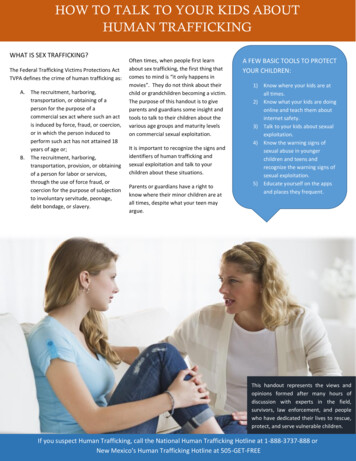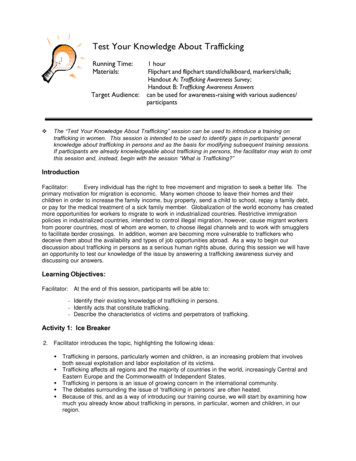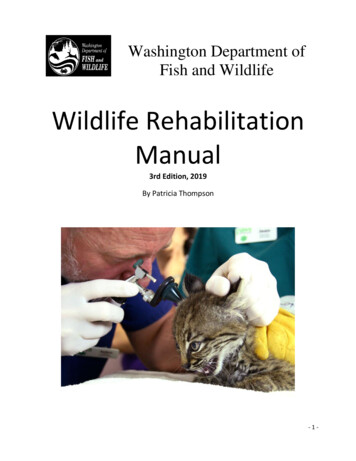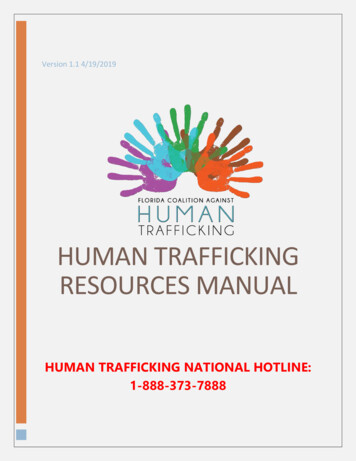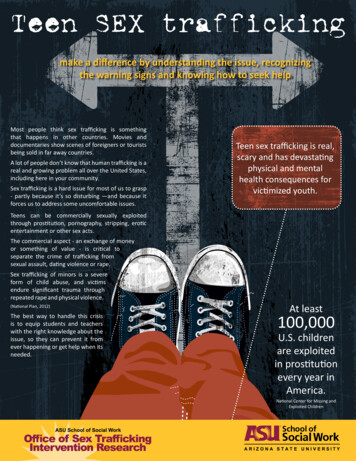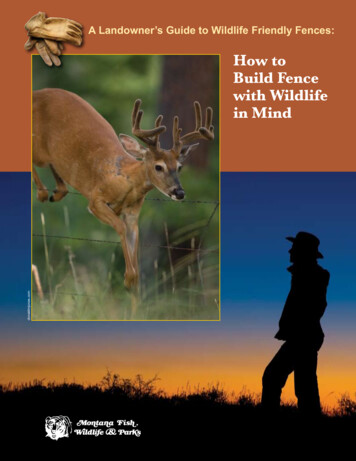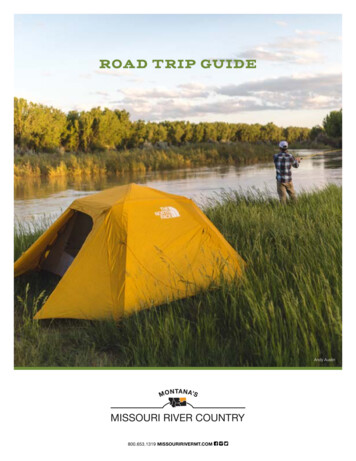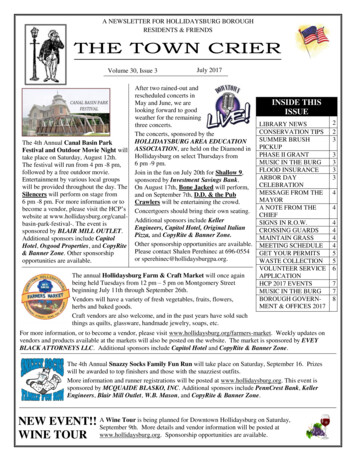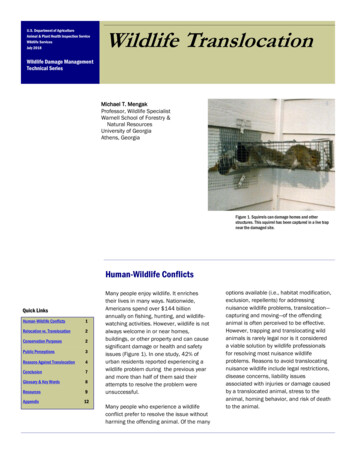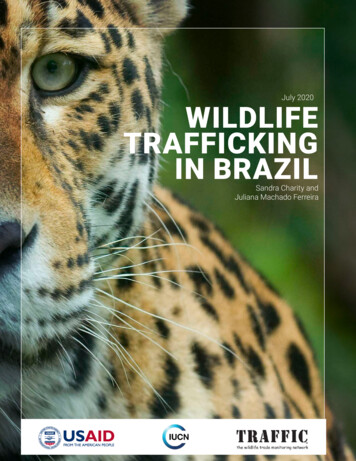
Transcription
July 2020WILDLIFETRAFFICKINGIN BRAZILSandra Charity andJuliana Machado FerreiraTRAFFIC: Wildlife Trade in Brazil
WILDLIFE TRAFFICKING IN BRAZILTRAFFIC, the wildlife trade monitoring network,is a leading non-governmental organisationworking globally on trade in wild animalsand plants in the context of both biodiversityconservation and sustainable development.Reproduction of material appearing in this reportrequires written permission from the publisher.The designations of geographical entities inthis publication, and the presentation of thematerial, do not imply the expression of anyopinion whatsoever on the part of TRAFFIC orits supporting organisations concerning thelegal status of any country, territory, or area, orof its authorities, or concerning the delimitationof its frontiers or boundaries. Jaime Rojo / WWF-USTRAFFICDavid Attenborough Building,Pembroke Street,Cambridge CB2 3QZ,UK.Tel: 44 (0)1223 277427Email: traffic@traffic.orgSuggested citation: Charity, S., Ferreira, J.M.(2020). Wildlife Trafficking in Brazil. TRAFFICInternational, Cambridge, United Kingdom. TRAFFIC 2020. Copyright of materialpublished in this report is vested in TRAFFIC. WWF-Brazil / Zig KochISBN: 978-1-911646-23-5UK Registered Charity No. 1076722Design by: Hallie SacksCover photo: Staffan Widstrand / WWFThis report was made possible with supportfrom the American people delivered throughthe U.S. Agency for International Development(USAID). The contents are the responsibility ofthe authors and do not necessarily reflect theopinion of USAID or the U.S. Government.TRAFFIC: Wildlife Trade in Brazil naturepl.com / Franco Banfi / WWF
July 2020WILDLIFE TRAFFICKING IN BRAZILPHASE 1 (January—March 2019) and PHASE 2 (August—November 2019)The USAID-funded Wildlife Trafficking, Response, Assessment and Priority Setting (WildlifeTRAPS) Project is an initiative that is designed to secure a transformation in the level ofco-operation between an international community of stakeholders who are impactedby illegal wildlife trade between Africa and Asia. The project is designed to increaseunderstanding of the true character and scale of the response required, to set priorities,identify intervention points, and test non-traditional approaches with project partners.
ACKNOWLEDGEMENTS Ricardo Lisboa / WWF-USFirst and foremost, we are hugely grateful to all the professionals and experts on illegal wildlifetrade from the Federal Police, IBAMA, ICMBio, Public Prosecutor’s Office and Federal HighwayPatrol who agreed to talk to us anonymously at a time of much uncertainty during the 2019government transition, and who were generous with their time and knowledge, and whosecommitment to finding solutions for combatting illegal wildlife trade in Brazil we greatly admire.Huge thanks go to Roberto Cabral Borges (IBAMA), Patrol Officer França (Federal HighwayPatrol), Dr Luciana Khoury (Bahia State Prosecution Office), Thomas Christensen (ICMBio) andPedro Develey (SAVE Brasil) for their generous time during several interviews and follow-up calls,and for sharing relevant information on the illegal wildlife trade in Brazil. We are also grateful toDiane Walkington, Thomas Lyster, Fabio Costa, Rodrigo Mairynk, Gabriela Nardoto and WorldAnimal Protection who helped produce information for the boxes and other parts of the report.Also, thanks to Angela Maldonado (Entropika, Leticia, Colombia) for sharing her knowledge andcontacts regarding illegal wildlife trade in the Amazon region.We are indebted to Claudio Maretti (former president of ICMBio), Carlos Alberto Scaramuzza(formerly Secretary of Biodiversity in the Ministry of the Environment), Denise Oliveira andMariana Napolitano from WWF-Brasil for their support, sharing of information and valuablecontacts during the planning phase for this assessment.We thank TRAFFIC and IUCN for the opportunity to carry out this assessment, and Robin Sawyerfor her guidance and support throughout the assignment. Additionally, we thank the United StatesAgency for International Development (USAID) for the resources to complete this work and theirreview of the assessment along with Nick Ahlers, Abigail Hehmeyer, Hallie Sacks, Crawford Allan,Richard Thomas and Steven Broad from TRAFFIC.We are also immensely grateful for the detailed research conducted by assistant consultantsJanaína Aparecida Monteiro and Railiane Abreu whose analysis of news outlets and the officialwebsites of several institutions helps to provide a different angle on the illegal wildlife trade inthe Amazon Region and the illegal bird trade in the northeast/southeast of Brazil.iiTRAFFIC: Wildlife Trade in Brazil
sIBAMAIBDFICMBioINC/PFIWTJBRJMMALEMPEMPFPRFSAVE -INLUSFWSWENWWF BrasilConvention on Biological DiversityCentre for Management and Conservation of Wild AnimalsCentro de Triagem de Animais Silvestres (wildlife reception centres)Convention on International Trade in Endangered Species of Wild Fauna and FloraComissão Nacional da Biodiversidade (National Biodiversity Commission, in the Ministry of theEnvironment)Comando de Policiamento Ambiental (state-level environmental police force, part of the MilitaryPolice)Centro de Recuperação de Animais Silvestres (state-managed wildlife rehabilitation centres)Gesellschaft für Technische Zusammenarbeit - Germany Technical Cooperation AgencyFiscalização Preventiva Integrada (integrated crime prevention mechanism involving federalstate and municipal level agencies as well as the Academia and civil society organisations)Instituto Brasileiro do Meio Ambiente e dos Recursos Naturais Renováveis (Brazil’s federalenvironment agency)Instituto Brasileiro de Desenvolvimento Florestal (Brazil’s former federal environment agency,before IBAMA)Instituto Chico Mendes de Conservação da Biodiversidade (Brazilian Institute responsible forfederal-level protected areas and biodiversity conservation)Instituto Nacional de Criminalística, Polícia Federal (National Forensics Institute of the FederalPolice)Illegal Wildlife TradeJardim Botânico do Rio de Janeiro (Rio de Janeiro Botanical Gardens)Ministério do Meio Ambiente (Ministry of the Environment)Law EnforcementMinistério Público Estadual (Public Prosecutor’s Office – State level)Ministério Público Federal (Public Prosecutor’s Office – Federal level)Polícia Rodoviária Federal (Federal Highway Patrol)Sociedade para a Conservação das Aves do Brasil (Society for the Conservation of Birds ofBrazil, the partner organisation of BirdLife in Brazil)Secretarias Estaduais do Meio Ambiente (state environmental agencies)National System for Wildlife Management: management and control of facilities and activitiesrelating to captive-held wildlife, including issuing of permits and operation of facilitiesDigital system for management and control of the non-commercial captive breeding of passerine birdsSouth America Wildlife Enforcement NetworkUniversidade de Brasilia (University of Brasilia)United Nations Office on Drugs and CrimeUnited Nations Convention against Transnational Organized CrimeUS Department of State, Bureau of International Narcotics and Law Enforcement AffairsUS Fish & Wildlife ServiceWildlife Enforcement NetworkFundo Mundial para a NaturezaTRAFFIC: Wildlife Trade in Braziliii
TABLE OF CONTENTSExecutive SummaryIntroduction1. Methodology2. Status of Brazil’s Biodiversity2.1Overview242.2Tools for protecting Brazil’s biodiversity253. Institutional Context and Information Systems4. Brazil’s Wildlife Legal Framework26294.14.24.34.44.54.64.7The birth of wildlife law in BrazilThe role of CITES in wildlife trade regulation in BrazilThe legal status of wildlife in BrazilResponsibilities for wildlife protection and regulationWildlife and the Environmental Crimes LawBrazil’s legal trade in wildlifeNon-commercial breeders of passerines293030313233354.8Conclusions of wildlife legislation section415. Overview of the Illegal Wildlife Trade in Brazil455.15.25.3Size and Scope of Brazil’s illegal wildlife tradeSize and Scope of the Domestic Illegal Bird TradeWildlife Capture Sites and Major Trade Routes4750605.4Placement and Release of Seized Animals626. Wildlife Trade in the Brazilian Amazon6.16.26.36.46.56.66.7Size and composition of illegal trade in the AmazonAmazon capture sites and major trade routesPlacement of animals seized from trade in the AmazonTrade in CITES-listed Amazon speciesTrafficking of jaguar parts in the Amazon regionWildlife tourism in the AmazonTransboundary and International Collaboration7. Information and Implementation Gaps8. Findings and Recommendations9. Referencesiv4212224TRAFFIC: Wildlife Trade in Brazil63647782848588889193100
EXECUTIVE SUMMARYContext and overview of illegal wildlife trade in BrazilBrazil is fortunate to have the planet’s largest biodiversity treasuretrove, with over 13% of the globe’s animal and plant life. Brazil alsoincludes 60% of the Amazon biome, which it shares with seven otherneighbouring countries (Bolivia, Peru, Ecuador, Colombia, Venezuela,Guyana and Suriname) and one overseas territory of France (FrenchGuiana). Two of Brazil’s five other major biomes—the Cerradosavannahs in the central part of the country and the Atlantic Forestalong its extensive and diverse coastline—are considered globalbiodiversity “hotspots”, although both are now severely threatened,having lost 51% and 91% of their natural vegetation cover, respectively.To date over 117,000 species of animals and 46,000 species of plantshave been described in Brazil, including 9,000 species of vertebrates,of which over 4,500 are fish, around 1,000 species of amphibians,more than 770 reptiles, almost 2,000 bird species and over 700mammals. Nonetheless, these numbers are growing all the time as aresult of frequent new discoveries. However, Brazil’s 2018 Red Bookof Threatened Species currently lists 1,173 wild species as eitherthreatened with extinction or extinct. Half of these are/were foundin the Atlantic Forest. One of the top threats is unsustainable wildlifetake and trade.This assessment explores Brazil’s role in illegal wildlife trade (IWT)identifying past and present wildlife legislation, institutional context,species targeted by trade, and recommendations that reflect currentneeds and priorities for combatting IWT in the country. Additionally,there is an in-depth look at illegal trade in the Brazilian Amazon anddomestic bird trade.Information was gathered in two phases: an exploratory phase togather up-to-date information on IWT in Brazil, and a more detailedassessment focused on illegal trade in the Brazilian Amazon witha secondary focus on the domestic bird trade. Data were collectedthrough interview, formal requests for information, and publiclyavailable research; qualitative analyses were carried out within eachindividual dataset.Wildlife law in BrazilKeeping wild animals as pets has been a cultural tradition inheritedfrom the country’s indigenous peoples. At the same time, Europeantravellers to Brazil in colonial times would take home exotic species,a practice which over time became a lucrative business and theprecursor of modern legal and illegal wildlife trade. Since the arrivalof the Portuguese in 1500, keeping or trading wild animals remainedunregulated in Brazil.The legal status of wild animals in Brazil was first defined in the 1916Civil Code, though wildlife trade regulation only started in 1967 with thepassing of the Fauna Protection Law no. 5197. In 1975, Brazil ratifiedthe Convention on International Trade in Endangered Species of WildFauna and Flora (CITES); however, the provisions of the Convention Anthony B. Rath / WWFTRAFFIC: Wildlife Trade in Brazilv
The 1988 Federal Constitution declared that the naturalenvironment, including wildlife, is an “environmentalgood of collective interest” which cannot be ownedprivately, and that it remains under the responsibility ofthe public authorities. This Constitution also introduceda new decentralised approach to assigning governmentresponsibilities for goods defined as “collective” orof “shared responsibility.” This requires all levels ofgovernment (federal, state, municipal, and FederalDistrict) to take responsibility for wildlife protection,research, management, combatting trafficking, andapplication of penalties for wildlife crime offences.In 2011, and based on the shared responsibilities principle,Complementary Law no. 140 was sanctioned definingrules for co-operation between the different levels ofgovernment, and as a result IBAMA handed over many ofits former responsibilities to the states and the FederalDistrict. However, sharing of responsibilities for wildlifeprotection between the federal and state levels has notbeen without its challenges, with frictions concerningnformation sharing and the distinct responsibilities ofeach government level.The 1998 Environmental Crimes Law weakened offencesand penalties of crimes against wildlife, althoughsubsequent legislation (Decree 3.179/99) enabledenvironmental control agencies to charge offenders andissue penalties on the spot.Brazil’s regulatoryframework forcombatting illegalwildlife trade hasevolved; currentlythere are numerousloopholes andinconsistencies,particularly regardingthe classification ofillicit acts againstwildlife and theseverity of penalties.Legal wildlife captive breeding can reduce theillegal trade in Brazil: a false premise?The 1967 Fauna Protection Law opened the possibility of legally breeding certain species in captivity,and over the last 50 years dozens of rules and regulations have been issued to regulate specifictypes of wildlife captive breeding programmes for different purposes (commercial, scientific, noncommercial, educational) targeting different taxa (caiman, marine turtles, passerine birds, primates,ornamental fish, and endangered species, amongst others).Like many other countries around the world, captive breeding of wild animals for conservation,education, commercial and non-commercial purposes is permissible by law in Brazil, although thereis extensive evidence of malpractice by many commercial wildlife breeding enterprises (e.g. caimanbreeders for the leather trade) as well as by commercial and non-commercial breeders of severalother species, especially birds.viTRAFFIC: Wildlife Trade in BrazilTigerleg Monkey Tree Frog WWF-Brazil / Zig Kochwere only fully translated into implementable legislation25 years later, when Brazil’s federal environmentagency, IBAMA, was designated as the Convention’sadministrative authority. Given the Convention’s nonprescriptive approach, Brazil’s regulatory framework forcombatting illegal wildlife trade has evolved accordingto the priorities of different legislatures; currently thereare numerous loopholes and inconsistencies, particularlyregarding the classification of illicit acts against wildlifeand the severity of penalties applied.
In addition to generational customs of keepingsongbirds as pets, major drivers of these illegalpractices are the hugely popular bird-singing contests(legal) and bird-fight competitions (illegal), whichmove large sums of money and are widespread inBrazil and other countries, including the United States.Consumer preference for wild-caught specimensin order to invigorate their breeding stocks and theabsence of effective controls on laundering practicesfuels the illegal trade. Moreover, commercial breedingis unable to offer animals at prices that are morecompetitive than those from the illegal trade, withprices charged for captive-bred birds up to 10 timesthe prices of wild-caught and illegally sold birds,undermining the role of captive breeding in replacingthe illegal trade.Chestnut-bellied Seed-finchIn Brazil, it is the legal non-commercial captive breedingof birds—strongly influenced by the widespreadculture of keeping and breeding songbirds—wheremost illegal practices occur, through the abuse bynon-commercial breeders of IBAMA’s self-declaratorymonitoring system for captive bred passerine birds(SISPASS), through forging of authorisations, falseregistration declarations, tampering with identificationrings, etc. These illicit practices allow for thelaundering of wild birds poached or illegally sourcedfrom the wild or sourced from the illegal trade. IBAMAstaff interviewed for this assessment estimatethat by 2015 around 75% of passerine birds on theSISPASS system had been added as a result of falsedeclarations and forgery of rings, a total of about threemillion birds registered through fraudulent practicesin order to launder wild or illegally traded birds. Since1972, when the amateur keeping and breeding of wildbirds was first regulated, the number of registeredbreeders has grown exponentially, reaching 73,000breeders in 2003/04 and almost 350,000 in 2016.By 2015, around 75% ofpasserine birds on theSISPASS system hadbeen added as a resultof false declarationsand forgery of rings,a total of about threemillion birds registeredthrough fraudulentpractices in order tolaunder wild or illegallytraded birds.Triggered by a growing suspicion that the SISPASSsystem was being abused, IBAMA launched a seriesof investigative operations including the highlysuccessful “Operation Delivery” and “OperationRussiona Roulette”. These Operations showed thatthere were irregularities, such as falsified rings,factories for manufacturing falsified rings, non-existent addresses, “phantom” registration of nonexistent birds, and commercialisation of birds by non-commercial breeders. Data recorded before,during and after “Operation Delivery” incursions reveal a sharp drop in requests for rings in theyears when “Delivery” operations are carried out, in some cases almost 97%. This provided IBAMAwith compelling evidence that requests for rings for newly hatched birds surpassed the number ofexisting chicks, thus creating a surplus of rings over time, which are then sold for high prices or usedfor laundering wild specimens. It is estimated that by 2010 registered breeders on SISPASS wereholding a surplus of almost 250,000 rings.There is enough evidence today that, whilst there are honest amateur keepers and breeders ofpasserine birds, there is also widespread fraud and malpractice within the category of amateurbreeders. Despite the numbers of commercial passerine breeders, and potential large supply of allthe most popular species, still the illegal trade in these species persists in alarmingly high numbers.TRAFFIC: Wildlife Trade in Brazilvii
Limitations of Brazil’s wildlife protection legislation and law enforcementapproachThere is a general acceptance that cultural factors play an important role in driving demandfor wild animals in the wild pet trade; changing consumer behaviour is a key componentto an effective strategy for combatting illegal wildlife trade (IWT) which is implementedthrough effective law enforcement, awareness campaigns and environmental education.Environmental authorities in Brazil, however, tend to use seizures of illegally kept animalsas the principal means of addressing IWT in Brazil. This type of repression of wildliferelated crime, on its own, has not succeeded in curbing the trade nor has it managed toaddress the cultural issues that sustain it. Two main explanations for this beyond culturalreasons are the relatively mild penalties defined in the applicable legislation and the lackof repression on the trafficking supply chains and kingpins.The complexity and multi-faceted nature of the trade requires a more sophisticated andmulti-pronged approach to tackle the issue effectively, one that differentiates betweenwildlife crime offences by animal trappers in rural areas at the beginning of the traffickingchain, consumers who purchase wild animals as pets, and active wildlife traffickinggangs who set up cargos, arrange transportation, and practice fraud and forgery ofdocumentation. The prevailing sense of impunity amongst wildlife traffickers stems fromthe fact that existing legislation does not consider wildlife trafficking a “serious crime”,with mild penalties that do not act as a disincentive to crimes against wildlife.Wildlife protection legislation in Brazil is extensive, complex and detailed. At the sametime, it is inadequate and imprecise, where it fails to provide a clear definition of wildlifetrafficking and is unable to differentiate between professional traffickers, opportunisticanimal sellers, and people who keep a few animals at home as pets. In addition, a numberof ill-conceived regulations have been passed over the years, such as CONAMA Resolution457 which rules that offenders caught trafficking wildlife or holding wild animals illegallycan in certain cases be appointed as “guardians” of the confiscated animals, a clearconflict of interest that undermines the efforts of agencies responsible for seizing illegallyheld wild animals.According to experts, even a simple increase in the penalties prescribed in the 1998Environmental Crimes Law would strengthen efforts to combat IWT in Brazil, as thiswould render this a “serious crime” allowing investigators to use investigative tools suchas phone tapping. Others are of the opinion that adding the term “wildlife” to existinglegislation (e.g. Article 180-A of the Penal Code) provides a better route to tackling wildlifecrime. Other stakeholders argue that a completely new criminal type needs to be defined,including a specific description of conducts related to wildlife trafficking offences andpenalties proportional to the damage and impacts caused.Nonetheless, the shortcomings of Brazil’s wildlife protection legislation, although acontributing factor to the relentless rates of biodiversity loss, cannot alone be heldresponsible for the ongoing illegal trade in birds, reptiles and mammals in the country—lackof resources, capacity and integration between agencies and forces are all contributingfactors as well.Illegal wildlife trade in Brazil: an overview and some numbersHard evidence of the size of the international illegal wildlife trade to and from Brazil isscant, although there have been seizures of internationally traded Podocnemis spp. (riverturtles), ornamental fish, Psittacidae eggs and nestlings, Jaguar Panthera onca parts,some Adelphobates spp. (poison dart frogs), other amphibians, shark fins, reptile skinsand leather. Some of these are discussed in more detail in the section on Amazon illegalviiiTRAFFIC: Wildlife Trade in Brazil
wildlife trade whilst others are beyond the scope of this assessment (e.g. shark fin,non-Amazon amphibians and reptiles).In terms of the domestic illegal wildlife trade in Brazil, up-to-date systematised figures,either official or academic, are not available due to the fragmented, incomplete andoften inconsistent datasets held by the various governmental agencies and policeforces responsible for enforcing wildlife protection legislation. For this reason,overall figures on wildlife trafficking in Brazil mentioned in the literature reviewedfor this assessment tend to be based on decades-old estimates of numbers of wildanimals removed from the wild across the country, smuggled, commercialised andpurchased by end-consumers, mostly in Brazil but also abroad. These estimateswere based on assumed pre-sale mortality rates resulting from capture methods,abandoned young in the wild, transport and captivity conditions, as well as lossesdue to discarded low quality wildlife products (e.g. reptile skins).Because more precise estimates of the numbers of animals taken from the wild aredifficult to obtain, seizure data are used as a proxy to assessing illegal wildlife tradein Brazil. This assessment provides the results of several partial analyses mentionedin the literature (collated during Phase 1), as well as new analysis of open datasetsaccessible on the websites of official agencies and police forces at the federal, stateand municipal levels, and new information obtained through Freedom Of InformationAct type requests (known in Brazil as e-sic requests). The data obtained from thesesources are intended to provide a snapshot of the size and composition of the illegaltrade in wildlife in general in Brazil, including the main source and destination regions: In 2008 alone, the IBAMA-managed wildlife reception centres (CETAS) acrossthe country received over 60,000 wild animals (the majority resulting fromseizures). Three main reception centres in São Paulo state (one IBAMAmanaged, one managed by the state government, one managed by themunicipal government) account for 80–90% of all wild animals received inthe state. However, this figure probably masks the actual number of seizedanimals as these numbers exclude wildlife parts, products and a considerablenumber of animals released by enforcement officers immediately after beingseized. (Destro et al., 2012)A 12-year study (2001–2012) using data compiled by CPAmb, the EnvironmentalMilitary Police Force of the State of São Paulo, revealed that this police forcealone had seized over 250,000 animals in the state over this period, about25,000 each year (SAVE Brasil, 2017).A study by Beck et al., 2017 (cited in SAVE Brasil, 2017) also used CPAmb data,and found that over a four-year period (2012 to 2015) the force responded to33,580 individual reports of offences involving wild animals. Over 90% of allcases involved wild birds, followed by mammals (7%) and reptiles (3%).The CPAmb, seized 32,420 animals in 2017; 32,509 in 2018; and 17,111 untilJuly 2019—a total of 82,040 between January 2017 and August 2019 from thispolice force alone in São Paulo state (obtained via e-SIC requests)According to one IBAMA interviewee, in 2018 more than 72,000 wild animalswere received by the IBAMA-managed CETAS across Brazil, of which 60–80%were apprehended by the state-level CPAmb police force in various states,another indication of the important role this police force plays in combattingIWT in the country.Main source regions are impoverished rural areas with well-preservedvegetation cover, often in the proximity of protected areas located mainly in thenortheast of Brazil (states of Bahia, Pernambuco, Paraíba, Piauí and Ceará),and the Amazon region in the north, as well as the states of Mato Grosso andGoiás in the central-west (Alves, 2013; Destro, 2018). Often the illegal sale ofwild animals is the only source of income for thousands of poor families inrural areas (Destro, 2018; Destro et al., 2019)TRAFFIC: Wildlife Trade in Brazilix
The main destination region for wild animals captured in the northeast, Amazon and central-westregions has historically been the southeast region of Brazil (São Paulo, Rio de Janeiro and MinasGerais) and the southern-most state of Rio Grande do Sul (Alves, 2013), a southwards flow that usesmainly roads for transportation of trafficked animals, except in the Amazon region where rivers arethe main transit routes. However, information obtained for this assessment from IBAMA and PRFinterviewees report the growth of a wildlife trafficking route from south/southeast/midwest to thenortheast and north of Brazil. An up-to-date map of major source and destination areas, as well asthe current trafficking routes is provided in the main document (Destro, 2018).Placement of the large numbers of animals seized from the trade by numerous enforcementagencies and police forces is a huge challenge. Police forces are allowed by law to release animalsthat are confiscated immediately at or near the sites where they were captured. Many thousandsof animals are relased in this way, and not always in accordance with appropriate guidanceand safeguards. If animals cannot be released at the site of seizure, they are referred to wildlifereception centres (CETAS and CRAS), which however tend to be over-crowded and under-resourced,and which can only take a limited number of animals. Despite existing criticism surrounding therelease of seized animals back into the wild, there is extensive evidence of successful release ofseized birds in natural and semi-natural habitats.The domestic illegal bird trade: numbers and target speciesWhilst a major focus for this assessment is on illegal wildlife trade in the Brazilian Amazon, a secondaryfocus on the current status of the vast domestic illegal bird trade is provided.Brazil’s domestic illegal bird trade takes place mainly in the northeast, southeast and central-westregions of Brazil. An initial analysis of bird data from IBAMA’s Open Data Portal1 carried out for thisassessment for the years 2018 and 2019 (partial) revealed a total of 21 species of birds with more than100 individuals seized over this period. The assessment lists the 15 species with the largest numbersof birds seized by IBAMA in nine states of the northeast (Maranhão, Piauí, Ceará, Rio Grande do Norte,Paraíba, Pernambuco, Sergipe, Alagoas, Bahia), four states in the southeast (Minas Gerais, São Paulo,Rio de Janeiro, Espírito Santo) and two states in the central-west (Goiás and Mato Grosso do Sul). Thetop five species listed are the Saffron Finch Sicalis flaveola, Red-cowled Cardinal Paroaria dominicana,Yellow-bellied Seedeater Sporophila nigricollis, Ruddy Ground-dove Columbina talpacoti and Greenwinged Saltator Saltator similis. However, if all Sporophila species were to be considered as a singlegroup, they would jump to second position. The highly endangered Lear’s Macaw Anodorhyncus leari,Great-billed Seed-finch Sporophila maximiliani and Yellow Cardinal Gubernatrix cristata also appearedin the IBAMA open data for seized birds in 2018 and 2019, all of which fetch very high prices in thedomestic and international markets.The IBAMA open data analysis for the 2018/2019 (partial) period reveals that the Saffron Finch was by farthe most seized species, with 31% of the total number of birds seized (3,115 individuals), an indication ofthe importance of this species in the domestic illegal bird trade in Brazil The popular Turquoise-frontedAmazon Amazona aestiva was th
a secondary focus on the domestic bird trade. Data were collected through interview, formal requests for information, and publicly available research; qualitative analyses were carried out within each individual dataset. Wildlife law in Brazil Keeping wild animals as pets has been a cultu
